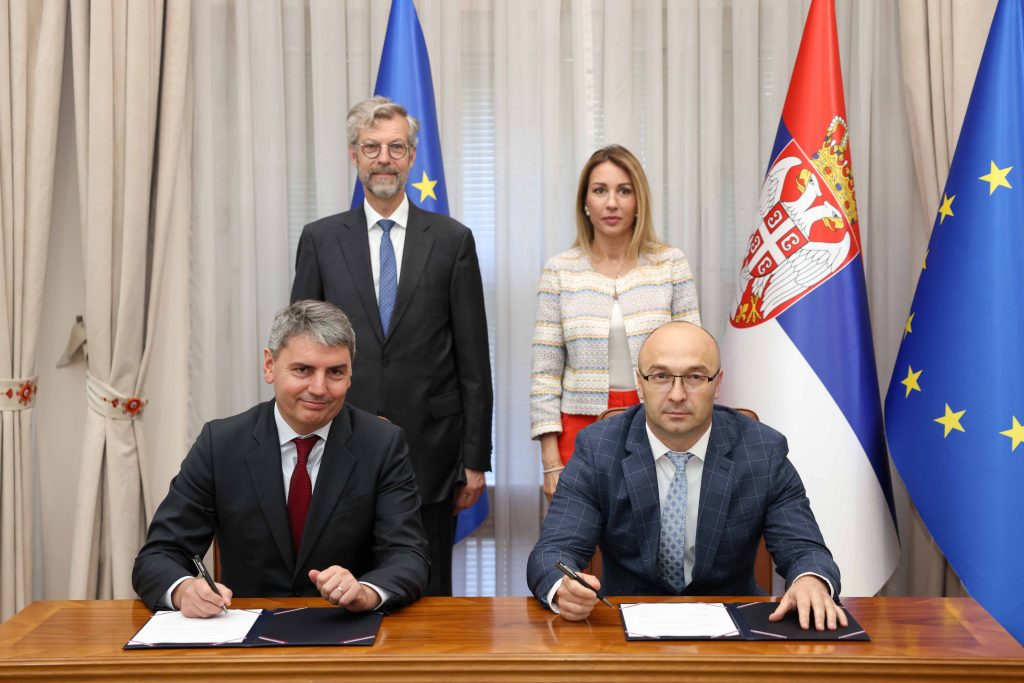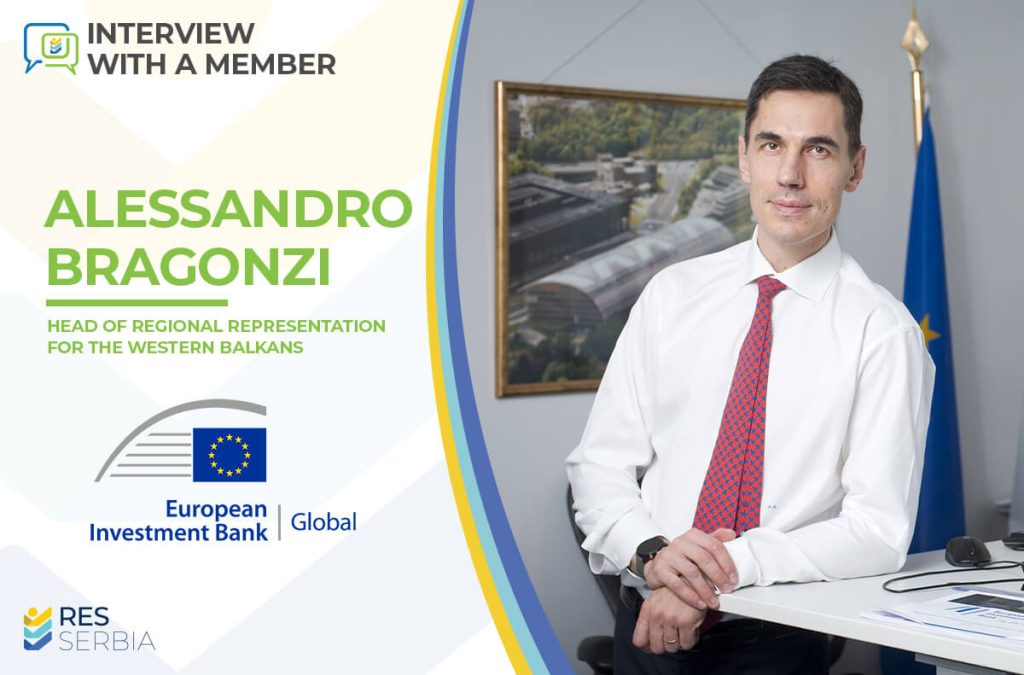The European Investment Bank (EIB) has invested €250 million in grants in the rehabilitation of the Belgrade-Nis railway; In June, it approved €200 million to support the greening of the production capacities of the Electric Power Industry of Serbia (EPS), and in July it signed €80 million with the Electric Power Distribution of Serbia (EDS) for the procurement and installation of smart meters – these are just some of the EIB’s investments in Serbia, which were pointed out by Alessandro Bragonzi, outgoing Head of the EIB Regional Representation for the Western Balkans, in an interview for the RES Serbia portal.
As he mentioned, EIB has invested €3 billion in new projects since 2021 for the Western Balkans region, mostly for modernization of the transport networks and the development of small and medium-sized enterprises, but also for the sectors of energy, education, water supply, sewage networks and healthcare.
Assessing Serbia’s energy transition, Bragonzi points out that with the adopted regulations for renewable energy sources and energy efficiency, many positive developments are visible.
At the same time, Serbia’s energy intensity is four times higher than the EU average, which requires both public and private investments in increasing energy security and switching to cleaner sources.
The world is now investing almost twice as much in clean energy ($2 trillion) as in fossil fuels ($1.2 trillion). The European Union spends $370 billion on clean energy, while China will spend nearly $680 billion in 2024.
Speaking about the obstacles to the development of renewables, Bragonzi also mentions the limitations of the grid, and as he says, estimates show that for every euro invested in new renewable energy sources, an additional euro will have to be invested in electricity grids.
In an interview for our portal, Bragonzi emphasizes that the EIB, which became a member of RES Serbia at the beginning of the year, is pleased to join our association in order to contribute to the creation of new opportunities, but also to solving the challenges related to the green transition.
You assumed the role of head of the European Investment Bank (EIB) for the Western Balkans in 2021 at a time when the world was recovering from COVID-19. When you sum up the last three years, are you satisfied with what has been achieved? What were the biggest challenges in these turbulent times?
– Thank you for this opportunity. Time flies!
As you’ve rightly pointed out, the world was still struggling with the COVID-19 crisis at the time of my appointment. Back then, the European Investment Bank was called upon to intervene and assume its traditional role of countercyclical economic policy instrument to help economies recover faster, while building and adapting the infrastructure to address critical challenges going forward. This has resulted in rapid and substantial financial and technical support delivered under what is called Team Europe – a partnership between the European Commission, the EIB and other financial partners forged to bring more effectiveness, resources and expertise.
Since then, the EIB Group also set up EIB Global, a dedicated arm for activities outside the European Union. This has enabled us to enhance our presence on the ground through teams of experts and hands-on support. Thanks to this approach, we signed €8.44 billion in financing for new projects across the world in 2023. The regional office in Belgrade has grown accordingly, hiring local experts in finance, energy, digital and transport infrastructure, helping to improve coordination with local stakeholders and better serve the other EIB representations in the region – in Tirana, Sarajevo and Skopje.
In the Western Balkans, our commitment to the EU accession process and sustainable development has remained steadfast. Our aim has been to help our local partners benefit from the EU financial opportunities envisaged under the latest initiatives such as the Economic and Investment Plan and, more recently, the new Growth Plan. In that regard, we have scaled up our technical assistance for the preparation and implementation of projects, while maximising the impact of partnerships around Team Europe to generate the most beneficial arrangements, combining loans, advisory support and EU grants channelled through the Western Balkans Investment Framework (WBIF).
Since 2021, the EIB has signed over €3 billion for new projects, mostly for the modernisation of transportation networks and SME development, but also for the energy, education, water, sanitation and healthcare sectors.

“In Serbia, cumulative economic growth in the period 2020-2022 was above 9%”
What changes do you see in Serbia and the region since the beginning of your mandate? What have we progressed in, and where can we still improve?
– Amid the global economic slowdown recorded in the past four years, the Western Balkans economies demonstrated resilience and managed to generate new jobs and growth, albeit unevenly. According to the OECD, employment rates in the region have the highest degree of convergence with the European Union, standing at 80% of the EU average, although with high youth unemployment rates. Furthermore, the OECD estimates that between 2003 and 2022, there was a 79% increase in the region’s average GDP per capita. However, it still only amounts to around 38% of the EU average, showing the need to close the existing gap.
We were also pleased to welcome the progress achieved with the enlargement agenda. Albania and North Macedonia opened accession negotiations in 2022. In March this year, the European Commission proposed opening accession negotiations with Bosnia and Herzegovina once the necessary degree of compliance with the membership criteria has been achieved.
In Serbia, cumulative economic growth in the period 2020-2022 was above 9%. In 2023, GDP grew by 2.5% and is projected to potentially be around 4% in the coming years, supported by the relatively dynamic manufacturing and service sectors, and substantial FDI inflows. Headline inflation peaked in Q1 2023 and has since been on a declining path – reaching 5% year on year in March. It is expected to fall back within the central bank inflation band by end-2024, supported by stable inflation expectations, moderate wage growth and an appreciating exchange rate.
For the region to progress further, fundamental reforms focusing on stability, institutional quality, private sector and skills development, and the green and digital transition will be essential. Focus should also be put on improving the business environment to address administrative and regulatory burdens, high informality and instability. The latest European Commission Growth Plan can further facilitate the EU accession process through a substantial (€6 billion in total) financial support package, combined with the acceleration of a common regional market and the gradual opening of certain areas of the EU single market to regional economies to ease free movement of goods, services, people and capital through harmonisation with the European Union.
The European Investment Bank invested €1.2 billion in the economies of the Western Balkans last year. A little less than half of that money was invested in Serbia, mostly for the rehabilitation of roads and railways. How much did the EIB invest in Serbia in green projects?
– Green projects go beyond energy and by contributing to the gradual shift to cleaner transportation options, such as railroad transport, they can help reduce greenhouse gas emissions. As you have mentioned, amongst others, we signed €250 million in EU grants for the rehabilitation of the Belgrade-Niš railway section on the Corridor X in Serbia.
On top of this, together with Banca Intesa Beograd, we unlocked a €100 million credit line aiming to enhance access to finance for small businesses in Serbia but also support potential projects in the areas of renewable energy and energy efficiency. As such, via partner banks, the EIB will support the overall decarbonisation of the private sector, while contributing to productivity, competitiveness and growth.
What are currently the most important green projects financed by the EIB in Serbia?
– When it comes to energy projects, the EIB has signed a €80 million loan this July with the electricity distribution operator EDS to procure and install smart meters and reduce network losses. On top of that, the EIB approved a €200 million loan in June to support the greening of the production capacity of the electric power industry of Serbia (EPS), in particular by rehabilitating existing hydropower plants to increase their efficiency and contribution to the overall energy mix.
Besides these large investments, I would like to mention innovative green projects supported under the EU for the Green Agenda in Serbia initiative. This initiative is financially supported by the European Union and implemented by the United Nations Development Programme (UNDP) and the Ministry of Environmental Protection, in cooperation with the Embassy of Sweden and the EIB, with additional funding coming from the Governments of Sweden, Switzerland and Serbia.
Thanks to the joint efforts of partners, over 50 innovative ideas originating from companies, local self-governments, scientific research institutions and organisations have been supported with financial and technical assistance provided by the European Union. These projects aim to deploy new technologies for tackling waste management, air pollution, environmental protection and integration of renewable energy into production processes.
In what way is the EIB involved in hydropower revitalisation projects in Serbia?
– As mentioned, the EIB recently approved financing for the modernisation of Serbia’s hydropower plants, including Bistrica HPP, which is set to be negotiated with Serbian government in the coming months. The project will extend the plants’ useful life and increase their generation capacity, aiming to considerably improve the security and reliability of energy supply in the country. In fact, rehabilitated HPPs will enhance the connection of more intermittent renewable energy sources (like solar and wind power plants) to the electrical power system.
Elektrodistribucija Serbia, with the support of the European Union, the European Bank for Reconstruction and Development (EBRD) and the EIB, is working on the installation of an advanced system of remote reading and installation of smart meters. What will this project bring to the citizens of Serbia?
– Together with EDS, we have signed a financial arrangement for the installation of about 400 000 advanced electricity meters, including the related IT infrastructure. This is part of the mass replacement of some 3.7 million obsolete electromechanical meters across the country. It is expected to result in reduced electrical grid losses and increased electricity savings, which will benefit both the citizens of Serbia and the energy market. Thanks to an EU contribution to the Serbian budget in late 2022, over 250 000 smart meters have been installed so far.

Signing a loan for smart meters
Although there was an expectation that the energy crisis would affect the decline of renewable energy storage (RES)’s popularity in the European Union, this did not happen. What would you single out as the biggest obstacles that slow down the development of RES in Europe?
– The world now invests almost twice as much in clean energy ($2 trillion) as it does in fossil fuels ($1.2 trillion), according to the International Energy Agency. The European Union spends $370 billion on clean energy (91% of total investments compared to 61% in the United States), while China is set to spend almost €680 billion in 2024, supported by its large domestic market and rapid growth in the so-called “three new” industries: solar cells, lithium battery production and electric vehicle (EV) manufacturing.
In 2023, European investment in renewables generation totalled almost $110 billion, an increase of more than 6% on the previous year. Investment in power grids rose by more than 20% in 2023 to nearly $65 billion, reflecting the need for more grid interconnection, especially to facilitate power flows to central European markets. A large portion of these achievements can certainly be attributed to the success of the REPowerEU Plan, adopted in 2022 in response to energy supply disruptions incurred by the Russian invasion of Ukraine.
In July 2023, the EIB increased its financing targets under this initiative by 50%, bringing them to €45 billion by 2027. This additional funding is expected to mobilise more than €150 billion in new green investments, which will help Europe reduce its carbon emissions to zero by 2050.
Regarding the obstacles that could slow down the intake of renewables, I would single out the length of administrative procedures and the non-uniform application of procedures and lack of technical capacity, including a shortage of necessary skills and grid constraints. Regarding the latter, the untapped potential is high. Estimates indicate that for every euro invested in new renewables, an additional euro will have to be invested in the electricity networks.
Serbia, in percentage terms, consumes more energy from renewable sources than Germany, France, Italy and many other countries of the European Union, as last year’s Eurostat report showed. How do you assess Serbia’s energy transition?
– With adopted regulations for renewables and energy efficiency, we can see many positive developments already. In 2023, the country presented its draft Integrated National Energy and Climate Plan, envisaging an increase in the share of renewable energy sources in gross final electricity consumption from 30% in 2021 to 45% by 2030. In that regard, EPS has launched a decarbonisation plan, which is adding new production capacity from renewables.
So, there is a positive momentum. At the same time, Serbia’s energy intensity is four times higher than the EU average, calling for both public and private investments to enhance energy security and the transition to cleaner energy sources.
You spoke about the importance of the energy transition several times at our conferences, and this year EIB became a member of RES Serbia. What would you say to our members?
– The EIB is really delighted to join the association and contribute to seizing opportunities, but also address challenges around the green transition.
In 2023, at the COP28 climate change conference, EIB Global presented its new approach to increase financing and advisory services in support of a just transition. We aim to focus initially on several countries in the region, including Serbia, to support workers affected by the green transition, projects in low-carbon infrastructure, energy efficiency, renewable energy, training, as well as environmental rehabilitation. By implementing these strategies, policymakers can work towards a just green transition strategy that minimises negative socioeconomic outcomes and promotes a more equitable and sustainable future.


